GIA certification is your diamond’s official quality report from the world’s most trusted gemological authority. When you buy a GIA-graded diamond, you’re getting an unbiased assessment of the stone’s cut, color, clarity, and carat weight by experienced gemologists who use rigorous standards. This certification validates your diamond’s authenticity, protects your investment, and guarantees you can make informed purchasing decisions with confidence. Discover how this process works to safeguard your purchase.
Understanding the Gemological Institute of America
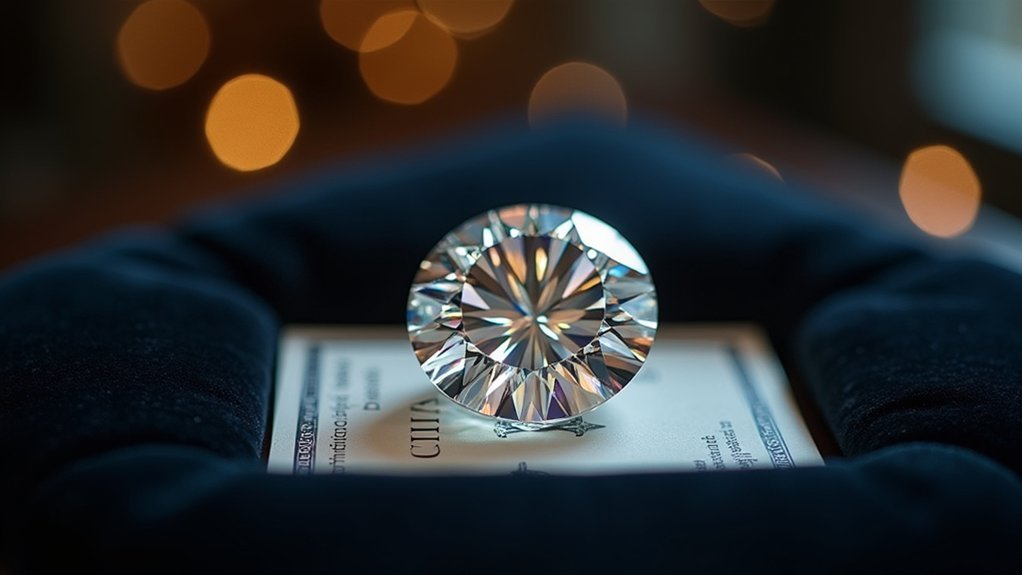
When you’re shopping for a diamond, you’ll likely encounter the GIA name on certification documents—and for good reason. The Gemological Institute of America stands as the world’s most trusted authority in diamond grading, operating as a nonprofit organization since 1931.
You can rely on their expertise because they’ve developed the internationally recognized 4Cs grading system that evaluates cut, color, clarity, and carat weight.
What sets GIA apart is their independence from the diamond trade, ensuring you receive an unbiased assessment of your diamond’s quality.
Whether you’re considering natural or lab-grown diamonds, GIA Diamond Grading Reports provide objective evaluations that you can verify through their online database, giving you confidence in your purchase decision.
What Makes a Diamond GIA Graded
Before a diamond earns its GIA certification, it must pass through a thorough evaluation process that examines every aspect of its quality and authenticity.
During GIA grading, your diamond receives a unique bar-coded label for tracking throughout the anonymous assessment process. At least two experienced graders independently evaluate the assessment of a diamond’s characteristics using the 4Cs framework.
The cut of a diamond undergoes precise measurement of proportions, polish, and symmetry.
Color grading determines the absence of color, while clarity evaluation identifies internal and external flaws. Carat weight provides exact measurements.
GIA reports document these findings plus any treatments your diamond has received.
This diamond quality verification process guarantees you’re receiving an unbiased, globally recognized evaluation that’s essential for purchasing decisions and insurance purposes.
The 4 Cs Standard and Diamond Quality Assessment
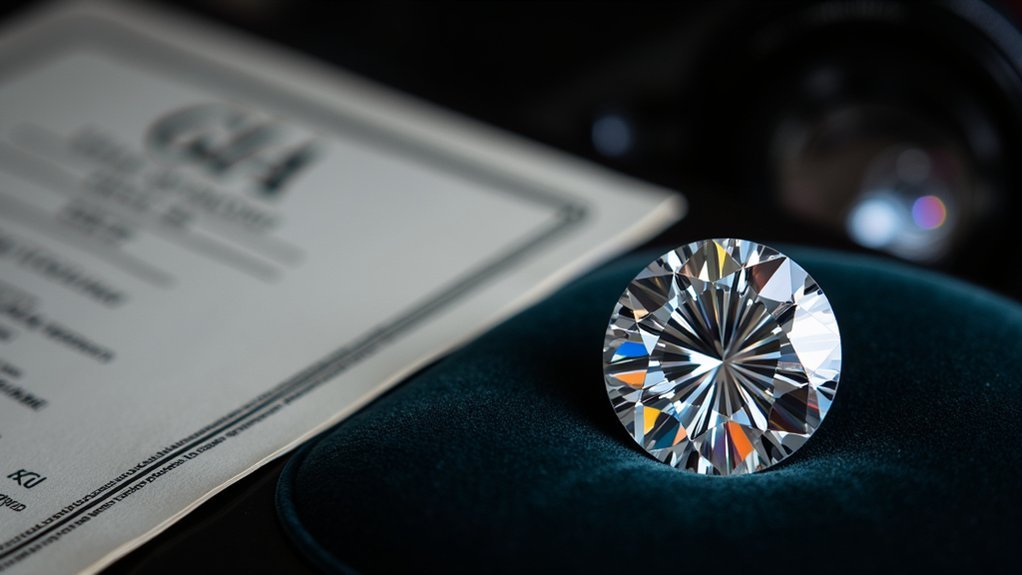
When you’re evaluating a GIA-certified diamond, you’ll encounter the industry’s gold standard: the 4 Cs assessment system that measures cut quality, color grading, and clarity evaluation.
Your diamond’s cut quality determines how brilliantly it’ll sparkle, while the color grading scale from D to Z reveals how colorless your stone is.
The clarity assessment process identifies any inclusions or blemishes that affect your diamond’s overall quality and value.
Cut Quality Standards
The foundation of diamond evaluation rests on the globally recognized 4 Cs system developed by the Gemological Institute of America (GIA): cut, color, clarity, and carat weight.
Cut quality stands as the most essential factor affecting your diamond’s brilliance and fire. The GIA grading process evaluates how well a diamond’s facets interact with light, assigning grades from Excellent to Poor.
When you’re examining a GIA grading report, you’ll notice cut quality directly impacts the diamond’s sparkle and overall visual appeal.
As a diamond buyer, understanding that superior cut quality can make a smaller stone appear more brilliant than a larger, poorly cut diamond helps you make informed decisions.
GIA certified diamonds with excellent cut grades maximize light performance and value.
Color Grading Scale
Moving beyond cut quality, color grading represents another fundamental component that directly affects your diamond’s beauty and market value.
GIA certification uses a standardized color grading scale ranging from D (colorless) to Z (light yellow or brown). This system evaluates your diamond’s hue, tone, and saturation under controlled lighting conditions to guarantee consistent results.
The color grade greatly impacts diamond value, with D-F grades being most desirable and expensive.
When you receive GIA reports, you’ll find detailed color assessments that help you understand your diamond’s quality level.
GIA’s rigorous standards mean you can trust the accuracy of each color grade, giving you confidence in your purchase decision and guaranteeing transparent diamond quality evaluation.
Clarity Assessment Process
After color evaluation, clarity assessment becomes equally essential in determining your diamond’s overall quality and value.
GIA grading evaluates inclusions and blemishes that affect your diamond’s appearance through rigorous examination under 10x magnification.
The clarity scale ranges from Flawless to Included, with each grade directly impacting market value. Higher clarity grades command premium prices due to their superior visual appeal and rarity.
Here’s what makes GIA’s clarity assessment reliable:
- At least two independent GIA graders examine each diamond for objective evaluation
- Transparent documentation in GIA reports details all clarity characteristics
- Standardized methodology guarantees consistent diamond quality assessment across all evaluations
- Clear classification system helps you understand exactly what you’re purchasing
This thorough assessment process gives you confidence in making informed diamond purchasing decisions.
GIA Grading Process and Objectivity Measures
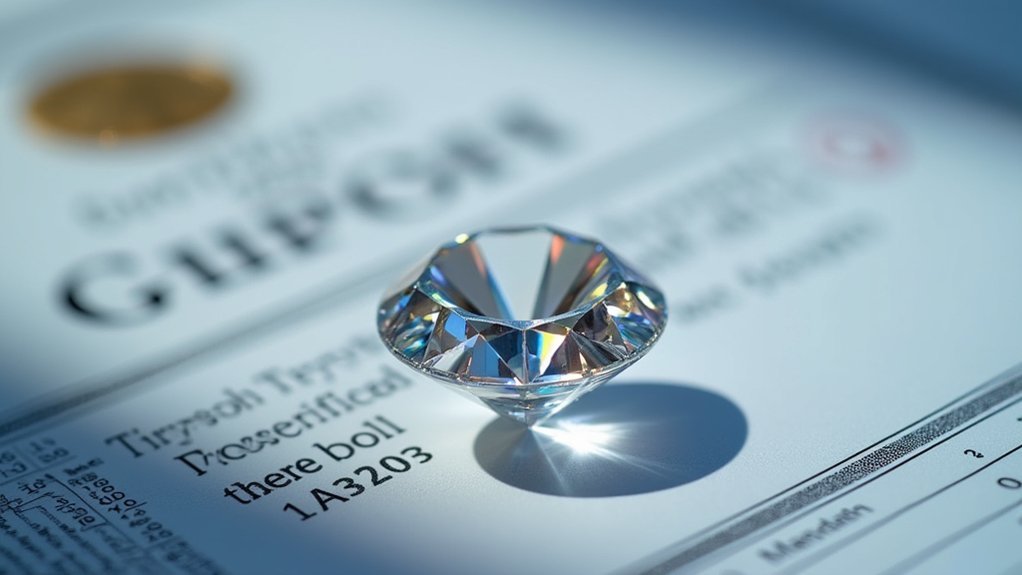
When you submit a diamond for GIA certification, it immediately enters an anonymized system designed to eliminate any potential bias from the evaluation process. Your diamond receives a bar-coded label for tracking while removing any identifying information about its source or owner.
The GIA grading process requires at least two experienced gemologists to conduct an independent inspection of your diamond’s characteristics.
They’ll evaluate all 4Cs—cut, color, clarity, and carat weight—along with detailed assessments of proportions, polish, symmetry, and fluorescence. This rigorous approach often involves multiple graders reviewing the same stone to reach consensus.
GIA’s status as a nonprofit organization guarantees objectivity in every evaluation, providing you with unbiased, transparent reports you can trust for making informed diamond purchasing decisions.
Types of GIA Diamond Reports Available
When you’re shopping for a certified diamond, you’ll encounter several types of GIA reports designed for different needs and budgets.
GIA offers detailed natural diamond reports that provide complete grading details, while online-only options deliver the same rigorous 4Cs analysis in a digital format.
Understanding these report variations will help you choose the certification level that matches your diamond purchase requirements.
Natural Diamond Reports
Understanding the landscape of GIA certification begins with knowing which type of report best suits your diamond purchase. When you’re buying natural diamonds, you’ll encounter several GIA graded options that provide thorough quality assessments.
The most common natural diamond report options include:
- GIA Diamond Grading Report – Complete evaluation of the 4Cs with detailed proportions and plotted diagrams for full transparency
- GIA Diamond Origin Report – Standard grading plus country of origin identification for added purchase confidence
- GIA Diamond Dossier – Streamlined report for 0.15-1.99 carat stones without plotted diagrams
- Online-Only Reports – Digital formats like eReport and Focus™ Report tailored for specific carat weights
Each report includes a unique report number you can verify through GIA’s online database, ensuring your diamond’s authenticity.
Online-Only Report Options
As digital technology transforms diamond certification, GIA’s online-only report options deliver the same rigorous grading standards you’d expect from physical documents while offering enhanced convenience and accessibility.
GIA reports offer two primary digital formats: the GIA Diamond eReport and the GIA Diamond Focus™ Report. The GIA Diamond eReport provides complete 4Cs grading results that you can access digitally, ensuring transparency in diamond quality assessment.
The Diamond Focus™ Report delivers detailed information on specific diamond weights while excluding plotted diagrams.
Both online-only report options allow you to verify specifications without physical documents, catering to different carat weights. This digital documentation enhances convenience for buyers preferring electronic verification while maintaining trust in GIA-graded diamonds.
How to Verify Your GIA Diamond Report
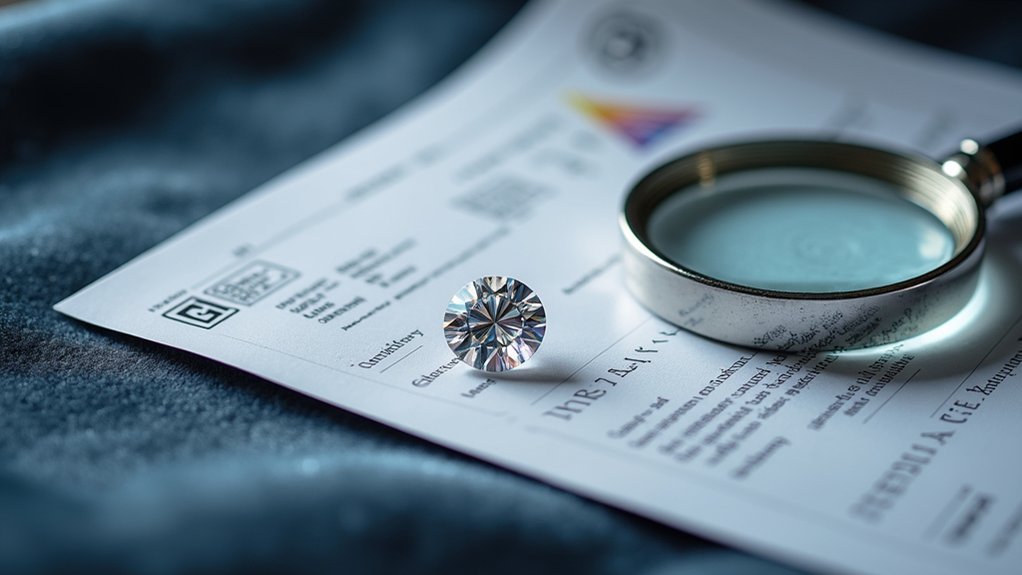
How can you guarantee your diamond’s GIA report is legitimate and accurate? Verifying your GIA certification affirms you’re getting exactly what you paid for and protects your investment.
Here’s how to verify your diamond’s GIA report:
- Find the report number on your GIA grading document and visit the GIA Report Check online database.
- Input the unique number to access thorough details about your diamond’s specifications.
- Confirm the 4Cs details (cut, color, clarity, carat weight) match exactly with what’s advertised.
- Check if it’s natural or lab-grown as specified in the original grading report.
Always cross-reference the report details with your actual diamond to guarantee perfect correspondence.
This verification process assures transparency and confirms the grading accuracy, giving you complete confidence in your purchase decision.
Benefits of Purchasing GIA Graded Diamonds
When you purchase a GIA graded diamond, you’re getting an accurate quality assessment that’s been evaluated by multiple experienced gemologists using consistent, worldwide standards.
This certification enhances your diamond’s market value since GIA’s reputation makes your stone more desirable to future buyers should you decide to sell.
You’ll also meet insurance coverage requirements, as many companies specifically require GIA reports to provide protection for your investment.
Accurate Quality Assessment
The unbiased evaluation provided by GIA grading reports guarantees you’ll receive an accurate quality assessment of your diamond’s quality across all four critical characteristics: color, clarity, cut, and carat weight.
When you purchase a diamond with a GIA certificate, you’re getting grading information that’s been meticulously evaluated by multiple experienced gemologists who maintain strict objectivity standards.
This thorough diamond grading process guarantees you won’t overpay for your purchase because you’ll know exactly what you’re buying.
Each diamond’s unique identification number connects to GIA’s global database, allowing you to verify all grading details instantly.
- Multiple gemologists independently evaluate each stone to eliminate bias
- Standardized grading criteria guarantee consistent assessments worldwide
- Detailed documentation provides complete transparency about your diamond’s characteristics
- GIA grades remain the industry gold standard for accurate quality determination
Enhanced Market Value
GIA-certified diamonds consistently command higher market values than non-certified stones, giving you significant advantages whether you’re buying or selling.
When you purchase GIA diamonds, you’re investing in stones with verified quality documentation that insurance companies require for coverage. This requirement alone enhances market value and protects your investment.
The trusted grading reports create buyer confidence through objective, unbiased assessments that eliminate guesswork about diamond quality.
You’ll find these reports make comparison shopping easier, helping you determine fair pricing while boosting the diamond’s perceived value.
GIA’s reputation as the leading grading authority increases demand for certified stones in resale markets.
This heightened demand translates directly into superior resale value, making your GIA-certified diamond a more valuable long-term investment.
Insurance Coverage Requirements
Since most insurance companies mandate GIA Diamond Grading Reports for coverage, you’ll find that purchasing certified diamonds isn’t just smart—it’s crucial for protecting your investment.
These reports provide the rigorous, unbiased evaluation that insurers need to accurately assess your diamond’s value.
When you’re dealing with insurance coverage, a GIA report offers several advantages:
- Streamlined claims process – Clear documentation eliminates guesswork during claims
- Full value recovery – Verified authenticity and specifications maximize your payout potential
- Accurate assessment – Precise grading guarantees proper coverage amounts from day one
- Investment confidence – Objective quality verification supports both initial coverage and future resale value
Without proper certification, you risk inadequate coverage or complicated claims processes that could leave you financially vulnerable.
GIA Grading Vs Other Diamond Certification Labs
When shopping for diamonds, you’ll encounter certificates from various grading laboratories, but not all certifications carry equal weight in the marketplace.
GIA grading stands apart from other certification labs due to its independent, nonprofit status and rigorous evaluation process. While some labs may offer inconsistent or lenient grading standards, GIA maintains strict objectivity through multiple grader assessments and standardized procedures.
This difference considerably impacts reliable evaluations and market value. Diamond reports from less stringent labs might inflate grades, leading to overpayment.
GIA’s consistent approach guarantees accurate assessments of the 4 Cs, whether you’re purchasing natural or lab-grown diamonds. The clear origin identification and unique report numbers enhance buyer confidence by allowing verification through GIA’s global database, making informed purchasing decisions possible.
Cost Considerations for GIA Graded Diamonds
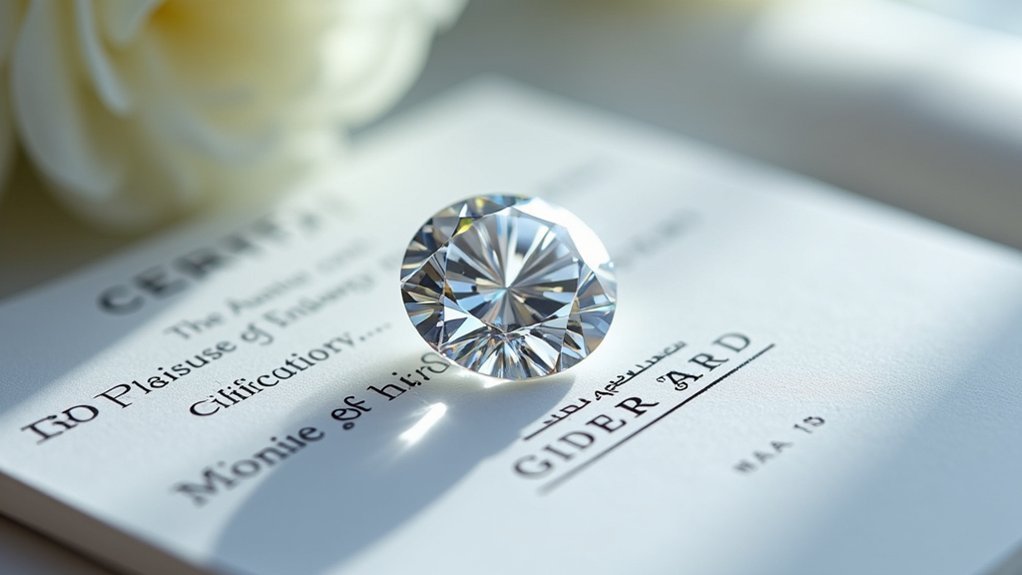
Although many buyers assume GIA certification adds significant cost to diamonds, the grading itself doesn’t inflate prices—the diamond’s inherent quality determines its value.
GIA certification provides quality assurance without necessarily creating premium pricing. Many retailers offer GIA graded diamonds competitively, sometimes even lower than non-certified stones. The cost of GIA graded diamonds fluctuates with market trends, not certification status alone.
Understanding your GIA grading report helps you pay a fair price based on actual diamond quality:
- Compare prices across multiple retailers offering GIA certified stones
- Use the 4 Cs details to verify you’re getting appropriate value
- Look for retailers who price GIA diamonds competitively with market rates
- Focus on the diamond quality metrics rather than just the certification itself
Smart buyers leverage GIA reports to make informed purchasing decisions.
Where to Find Reputable GIA Diamond Retailers
Where should you shop for GIA certified diamonds to guarantee authenticity and quality? Since GIA is a nonprofit organization, you’ll find their graded diamonds through various retail jewelers who prioritize credibility and buyer confidence.
| Retailer Type | Key Features | Benefits |
|---|---|---|
| Online Retailers | James Allen, Blue Nile exclusives | Detailed inspection tools |
| Local Jewelers | GIA Retailer Lookup verified | In-person examination |
| Online Marketplaces | GIA standard filters | Simplified selection process |
Retail jewelers selling GIA-graded diamonds enhance your shopping experience through trust and transparency. Use the GIA Retailer Lookup to locate trusted local sources. Always verify your diamond includes a GIA Diamond Grading Report with a unique report number. This diamond grading documentation allows authenticity verification through GIA’s online database, ensuring you’re purchasing genuine GIA-graded diamonds.
Reading and Understanding Your GIA Diamond Report
Your GIA Diamond Grading Report serves as your diamond’s official identification document, containing all the critical information you need to understand your purchase’s true value and characteristics.
This GIA certification provides extensive details about your diamond’s quality through the 4Cs evaluation system.
Key elements you’ll find in your diamond grading report include:
- Unique identification number – Verify authenticity through GIA’s online database during your purchase process
- Clarity assessment – Shows your diamond’s grade and plotted diagram revealing inclusions locations
- Complete 4Cs data – Color, clarity, cut, and carat weight specifications for accurate quality assessment
- Additional characteristics – Polish, symmetry, fluorescence, and proportions for thorough evaluation
Understanding these details empowers you to make confident decisions and validates your investment’s authenticity and quality.
Frequently Asked Questions
Is It Worth Buying a GIA Certified Diamond?
Yes, you’ll find GIA certified diamonds worth buying because they guarantee accurate quality assessment, authentic verification, insurance coverage eligibility, and protection against overpaying, making your investment safer and more reliable.
How Much Does It Cost to Get a GIA Certificate for a Diamond?
You’ll pay $150 to $1,200 for GIA certification, depending on your diamond’s carat weight. Larger stones cost more due to complex grading requirements. You’ll pay additional fees if you want extra services.
What Does It Mean to Be GIA Certified Diamond?
A GIA certified diamond means you’re getting a stone that’s been professionally evaluated by the Gemological Institute of America. You’ll receive an unbiased grading report documenting the diamond’s cut, color, clarity, and carat weight.
Can You Sell a Diamond Without a GIA Certificate?
You can sell a diamond without GIA certification, but you’ll likely face reduced marketability and lower offers. Buyers often hesitate purchasing non-certified diamonds due to uncertainty about quality, authenticity, and value.
In Summary
You’ll find GIA certification provides the most trusted diamond grading standards in the industry. When you’re investing in a diamond, you can’t afford to compromise on authenticity and quality assessment. GIA’s rigorous grading process guarantees you’re getting exactly what you pay for. Don’t settle for lesser certifications that might leave you questioning your purchase. Choose GIA-certified diamonds from reputable retailers, and you’ll have confidence in your investment for years to come.

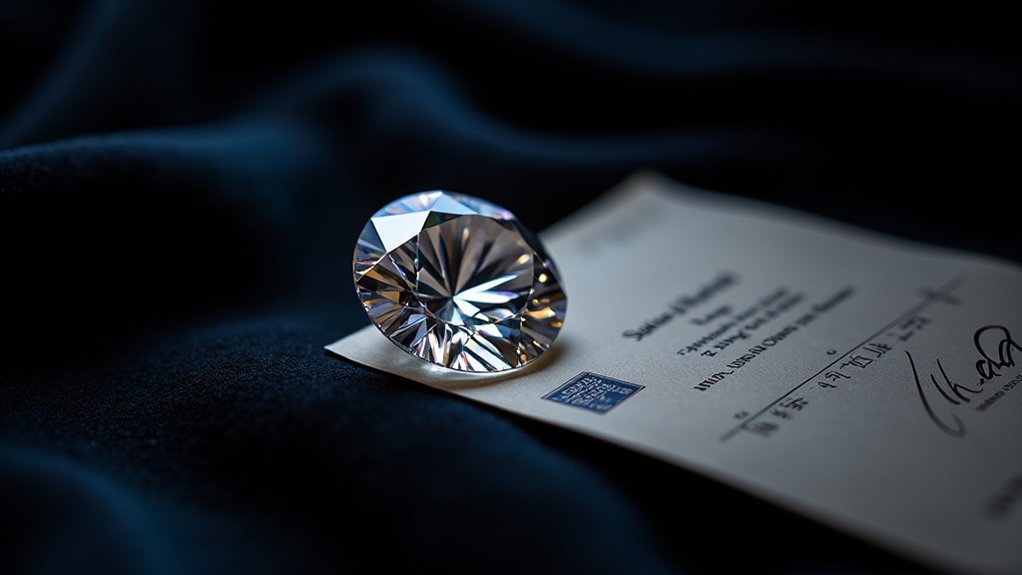

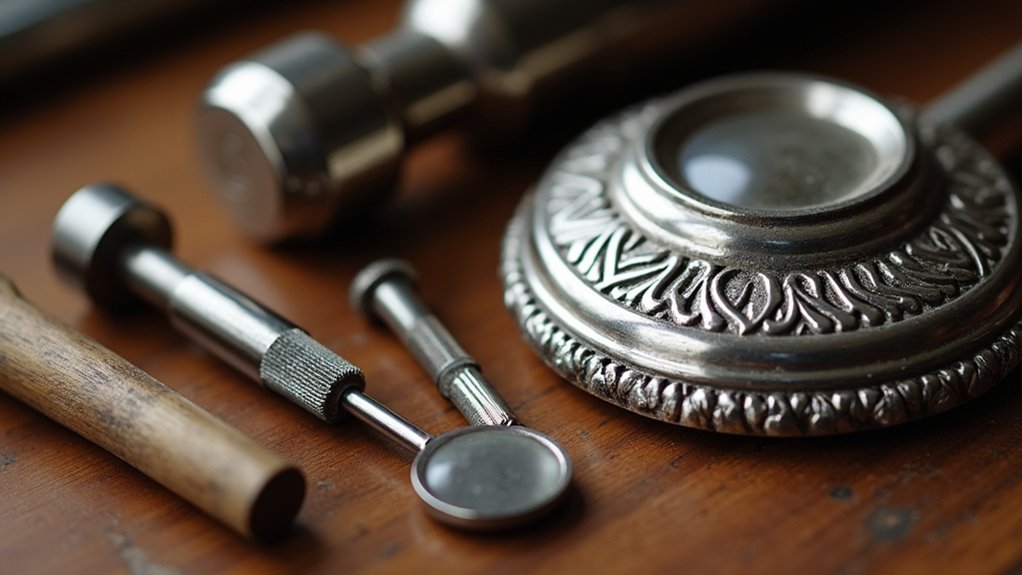
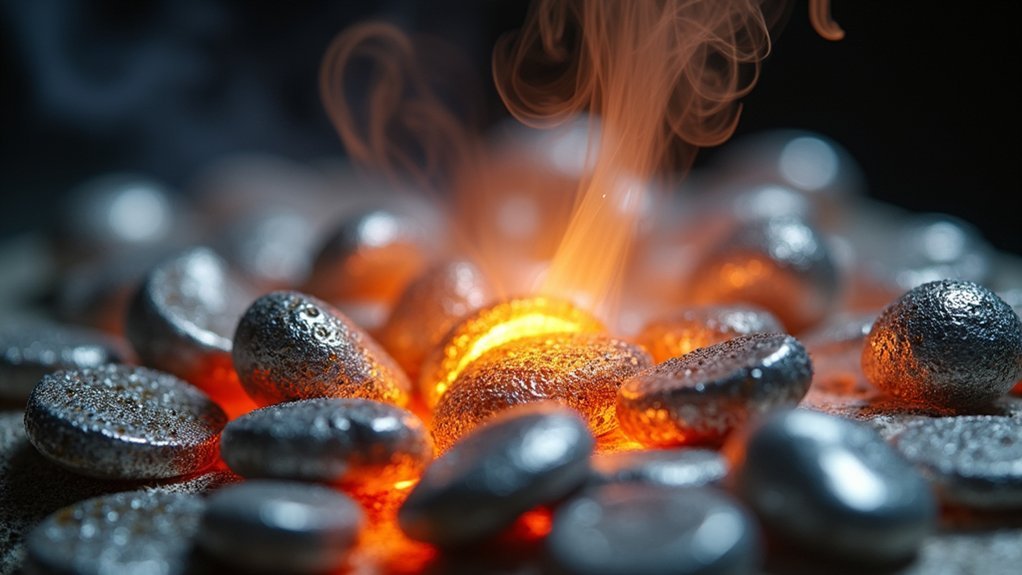
Leave a Reply